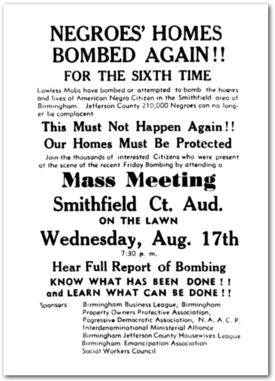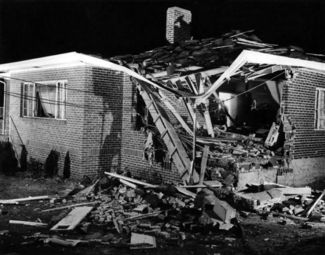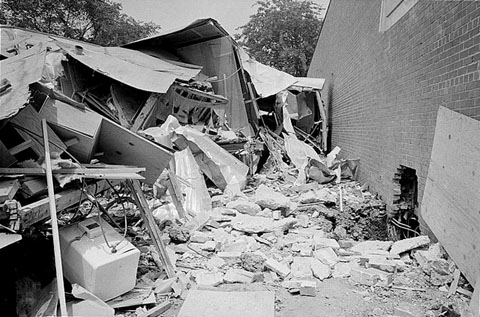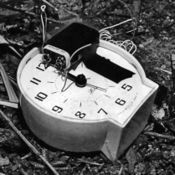List of racially-motivated bombings
This is a list of racially-motivated bombings, events in a long series of terrorist actions aimed at cowing proponents of racial desegregation in Birmingham and surrounding areas.
Numerous explosive devices were placed near African American leaders' homes and meeting places during the Civil Rights Movement of the 1950s and 1960s. Many others targeted black families moving into neighborhoods that had previously been zoned for whites, or individuals of any race alleged to be have supported the cause of integration. Historians have connected the materials and methods used by racially-motivated bombers to earlier outbreaks of labor-related violence and intimidation.
Most of these crimes went "unsolved", due to complacency, or perhaps complicity, on the part of local law enforcement agencies and the FBI. The frequency of such acts led to the use of the derisive nickname "Bombingham" for the city. Locally, the preponderance of bombings focused around Center Street at the boundary of Smithfield and Graymont, where a lawsuit filed by Arthur Shores had prevented the city from enforcing its racial zoning ordinance, led to that area being called "Dynamite Hill".
Author Diane McWhorter documented numerous connections between these bombings and similar campaigns conducted as part of violent conflicts between mine companies and organized labor in the early 20th century. Robert Chambliss was frequently seen in the area, sometimes making overt threats, and was occasionally arrested on suspicion of involvement in bombings. He was not convicted and was generally understood to enjoy the sanction of Public Safety commissioner Bull Connor.
Notable bomb incidents
1947
- August 18: The first bombing targeted a new home constructed by Samuel Mathews on a vacant lot at 120 11th Court North in North Smithfield. He had purchased the property, which was planned to be rezoned for Black residents, in 1946. After being denied an occupancy permit he retained Arthur Shores to represent him in a suit against the city. U.S. District Court Judge Clarence Mullins ruled in favor of Matthews on July 31, 1947. Afterward Mathews found a skull and crossbones painted on the side of the house. A few days later six sticks of dynamite were thrown through the living room window, destroying the $3,700 house. Mathews reported the crime to police. Detectives claimed that their investigation "failed to reveal sufficient evidence to make an arrest." The event touched off what some termed the "Battle of North Smithfield".
1948
- A bomb exploded in front of Frank Davis' residence at 1100 Center Street.
1949
- March 24: The home of Bishop S. L. Green at 1st Street and 11th Avenue West was the hardest hit of three homes damaged by dynamite. The home was being remodeled for them at the time of the blast. The back porch of an adjacent home was also blown off.
- July 28: Three sticks of dynamite were thrown into the home of Reverend Milton Curry Jr at 1100 Center Street North, but did not explode.
- August 12: Curry's residence was again targeted by dynamite, this time damaging windows. At the time, Reverend Benjamin Henderson was renting a ground floor room in the house, which he shared with his 14-year-old son, Bennie.
- August 12: The home of E. B. DeYampert at 1104 Center Street North was damaged by dynamite on the same evening.
- On August 17 a mass meeting was held on the lawn of the Smithfield Court auditorium to hear witness reports of the bombings and to call for investigation and prosecution of the guilty. The meeting was co-sponsored by the Birmingham Business League, Property Owners Protective Association, Progressive Democratic Association of the NAACP, the Interdenominational Ministerial Alliance, the Birmingham Jefferson County Housewives League, the Birmingham Emancipation Association and the Social Workers Council. More than 2,000 people attended the protest, at which resolutions calling for an end to bombings, for increased access to real estate, and in support of attorney Arthur Shores were approved.
- September: A bomb attributed to the KKK damaged WEDR-AM's broadcast antenna.
1950
- April: Joel Boykins' newly-built home and dentist office in Smithfield was bombed. The event prompted the Birmingham Chapter of the National Council of Jewish Women to condemn such crimes and urge the police to investigate and prosecute.
- April 22: Milton Curry Jr's home was targeted a third time. The larger bomb nearly destroyed the house entirely. Two people inside escaped without injury.
- July 29: Pamphlets printed by the Alabama Communist Party in which the ongoing "unsolved" bombings were prominently mentioned, were scattered onto the street from a 10th floor window of the Woodward Building by New York resident George Breland.
- December 21: A brick bungalow belonging to Monroe and Mary Means Monk at 950 Center Street North was bombed. Mrs Monk had won a court judgment nullifying Birmingham's revised segregated zoning laws and had moved into the house on the west side of the street the previous day. The bomb was tossed onto the porch adjoining the room where the Monks were sleeping. Neither the Monks nor their boarder, C. W. Askew, were seriously injured.
1951
- The rear half of Milton Curry's home at 1100 Center Street North was burned to the ground.
1956
- A home was damaged by dynamite thrown into the front yard.
- December 25: 1956 Bethel Baptist Church bombing: Fred Shuttlesworth's residence in Collegeville bombed, collapsing the parsonage. The adjacent Bethel Baptist Church was also bombed, shattering windows.
1957
- April 10: Two days after George Dickerson, pastor of 1st Baptist Church Kingston, bought the house at 1143 12th Place North it was extensively damaged by a dynamite blast.
- April 28: Ashbury Howard residence in Bessemer.
- April 28: The Allen Temple AME Church at 9th Avenue and 22nd Street in Bessemer was bombed during a service, showering the choir with plaster debris.
- July: A home under construction on Dynamite Hill
- A double explosion destroyed a home at 1216 13th Street North in Fountain Heights.
- November: A home under construction in Bessemer
- December: One explosion damaged five houses on Dynamite Hill
1958
- April 28: Temple Beth-El, 54 sticks of dynamite were placed, but failed to go off after being doused by rain.
- May: Dora Muldin residence in Birmingham
- June 29: 1958 Bethel Baptist Church bombing: Bethel Baptist Church in Collegeville was targeted again. Guards managed to move a paint can full of dynamite from the church to a ditch before it exploded, but nearby windows were still blown out by the blast. J. B. Stoner was convicted on federal charges of conspiracy in the incident, and served 3½ years of a 10-year sentence before being paroled.
- July: William Blackwell residence
- Following a pair of bombings of houses in Fountain Heights, two white men were captured by black residents and beaten. They were arrested when they later sought medical treatment at University Hospital. The investigation led to one additional arrest. One of the three was convicted on a bombing charge and all three pleaded guilty a second charge of "attempting to set off a bomb". They were all given probation rather than imprisonment.("To Keep the Record Straight"-1963)
1959
1960
1961
1962
- January 16: New Bethel Baptist Church at 13th Avenue and Sipsey Street in East Birmingham was damaged by two sticks of dynamite.
- January 16: St Luke's AME Zion Church at 3937 12th Avenue North was damaged by two sticks of dynamite.
- January 16: Triumph the Church and Kingdom of God in Christ, Temple No. 7, at 2505 24th Street North was damaged by two sticks of dynamite.
- January: 4-unit apartment house under construction
- December 14: 1962 Bethel Baptist Church bombing: Bethel Baptist Church was bombed a third time, the explosion occurred across the street, but still shattered windows at the church and parsonage.
- December 18: The 28-unit Continental Apartments, under construction at 1607-1609 13th Avenue South was damaged by a small bomb, perhaps just a half-stick of dynamite, placed inside a front room.
1963
- March: Howard Robinson residence in Birmingham
- May 11: A. D. King's residence at 721 12th Street in Ensley was hit by two bombs that exploded minutes apart. The home was destroyed.
- May 11: A. G. Gaston Motel
- August 10: St James United Methodist Church in Warrior was destroyed by arsonists.
- August 15: Loveman's department store was targeted by a tear gas bomb.
- August 20: Arthur Shores' residence was damaged by a bomb tossed toward the garage doors. Shores was asleep at the opposite end of the house and was unarmed. One of the family's two dogs was killed and the other ran away.
- September 4: Arthur Shores' residence. Bomb exploded while repairs were underway from previous blast. His wife, Theodora was injured.
- September 12: A. G. Gaston's residence in Robin Wood
- September 15: 16th Street Baptist Church, 19 sticks of dynamite exploded on Sunday morning, killing 4 young girls.
- September 25: Two bombs exploded in Center Street South in Titusville, apparently intended to draw a crowd and then spray them with shrapnel. No one was hurt, but a deep crater was left in the street and shrapnel was sprayed into nearby walls. The homes of John Hardrick and Estalla Nunn were damaged by the second blast.
1964
1965
- March 21: Our Lady Queen of the Universe Catholic Church, at 10th Avenue North and Center Street was targeted during Mass by a bomb containing 50 sticks of dynamite. It was disarmed while the priest continued the liturgy.
- March 21: Another 50-stick bomb was left at A. D. King's residence in Ensley, but failed to explode.
- April 1: At 5:35 AM a bomb exploded at the house of Toussaint and Ruth Crowell at 1312 4th Avenue North, leaving a six-foot crater and injuring their 13-year-old son, Weymouth.
- 38 sticks of dynamite were found on the front porch of Nina Miglionico's home at 931 Essex Road. Her father, Joe discovered the device and disarmed it before it exploded.
- An unexploded bomb containing 50 to 60 sticks of dynamite was found at the home of Mayor Albert Boutwell at 4461 Clairmont Avenue. A Birmingham Police Department captain disarmed the device.
References
- "Red Propagandist Loses State Appeal" (November 2, 1951) Associated Press / The Tuscaloosa News
- "To Keep the Record Straight" (March 28, 1963) Birmingham Post-Herald - via Birmingham Public Library Digital Collections
- "20th Bombing Here Against Negroes" (September 16, 1963) Birmingham Post-Herald - via Birmingham Public Library Digital Collections
- "Complain 18 Unsolved B'ham Bombings in 6 Years." (September 19, 1963) Jet magazine. Vol. 24, No. 22
- Britton, John H. (April 29, 1965) "Deadly Little Green Boxes" Jet
- Eskew, Glenn T. (December 1997) "'Bombingham': Black Protest in Postwar Birmingham, Alabama." The Historian" Vol. 59, No. 2. p. 371-390
- Temple, Chanda and Jeff Hansen (July 16, 2000) "Ministers' homes, churches among bomb targets." The Birmingham News
- McWhorter, Diane (2001) Carry Me Home: Birmingham, Alabama, The Climactic Battle of the Civil Rights Revolution. New York, New York: Simon and Schuster. ISBN 0743226488
- White, Marjorie; Christy Anderson, and David Ray (December 13, 2006) "Center Street Historic District" National Register of Historic Places Nomination Form - listed October 1, 2007
- Gray, Jeremy (July 24, 2018) "Bombingham: Decades of racist bombings captured in chilling photos" The Birmingham News



